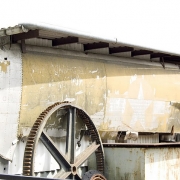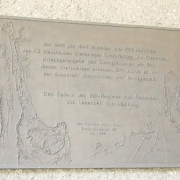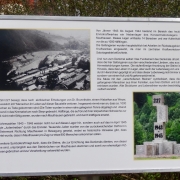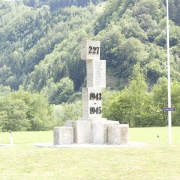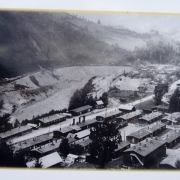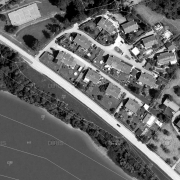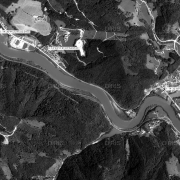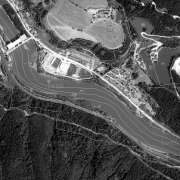Satellite Camp Großraming
Gründung des Konzentrationslagers
Großraming Subcamp was part of the “Gemeinschaftslager Ennskraftwerkbau” (Community camp for Enns power plant construction) and was established on 14 January 1943. The barracks were built in December 1942 and during the first two weeks of January 1943.
Lokalisierung
The camp was located directly by the Enns river, in the municipal district of Reichraming, about 30 km south-east of Steyr, and it was a complex consisting of 14 barracks. The subcamp was built right next to the Eisenstraße, slightly into the hillside, and it was surrounded by an electric barbed wire fence enforced by guard towers. The roll-call ground was in the middle of the camp.
Informationen über die Häftlinge
Almost half of the prisoners were politically persecuted persons from Yugoslavia, the others were from Germany, Poland, Russia, Greece, Spain, and other countries. A total of 1,800 prisoners between 19 and 56 years of age were brought to Großraming; the highest number of prisoners was recorded on 13 July 1944, with 1,027 people. The strenuous labour, the insufficient supplies and the acts of violence by the SS claimed 227 victims whose names are known. The real number is likely much higher, as almost a third of the prisoners - classified as unfit for work - were brought back to Mauthausen and replaced by new ones. According to SS archives, 17 prisoners were “shot on the run”, and seven committed suicide.
Zwangsarbeit
The prisoners of Großraming Subcamp had to work on the power plant construction site and had to carry out development works. The construction companies Rella & Co and Kunz & Co carried out the construction works for the power plant. For the strenuous earth- and stone works, they mostly used the prisoners and equipped them only with simple tools and wheelbarrows. Between January 1943 and July 1943, the death rate of the prisoners rose quickly.
Bewachung
SS guard members of the subcamp whose names are known were camp leader SS-Obersturmführer (Senior Assault Leader) Karl Schöpperle, SS-Obersturmführer Julius Ludolf, and SS-Untersturmführer (Junior Assault Leader) Hans Altfudisch. Protective custody camp leaders Kofler, Hans Riegler, and Herbert Winkler also show up in the records. Other members of the guard were Siegfried Buhr, Josef Schiller, Gottlieb Muzikant and warden of the dog kennel Fritz Schallenberg. The same punishments, tortures, and types of murder as in Mauthausen Concentration Camp were used in Großraming Subcamp, with the exception of poison gas: “Baum, Bock und Bunker” (Tree, Gantry and Bunker, which were different methods of torture), shooting, hanging, pushing into the electric fence, drowning, slaying, killing by dogs, starving.
Schließung
Construction work at the plant was largely ceased in September 1944, and the remaining prisoners were brought back to Mauthausen Concentration Camp on 29 August 1944. In December 1944, preparation work for the arms production of a factory was started at the camp.
Gedenken und Erinnern
In 1995, the Ennskraftwerke AG and the Mauthausen Committee Steyr put up a memorial plaque. Another memorial was erected in 2009 at the Großraming roundabout, which commemorates the murdered prisoners.

